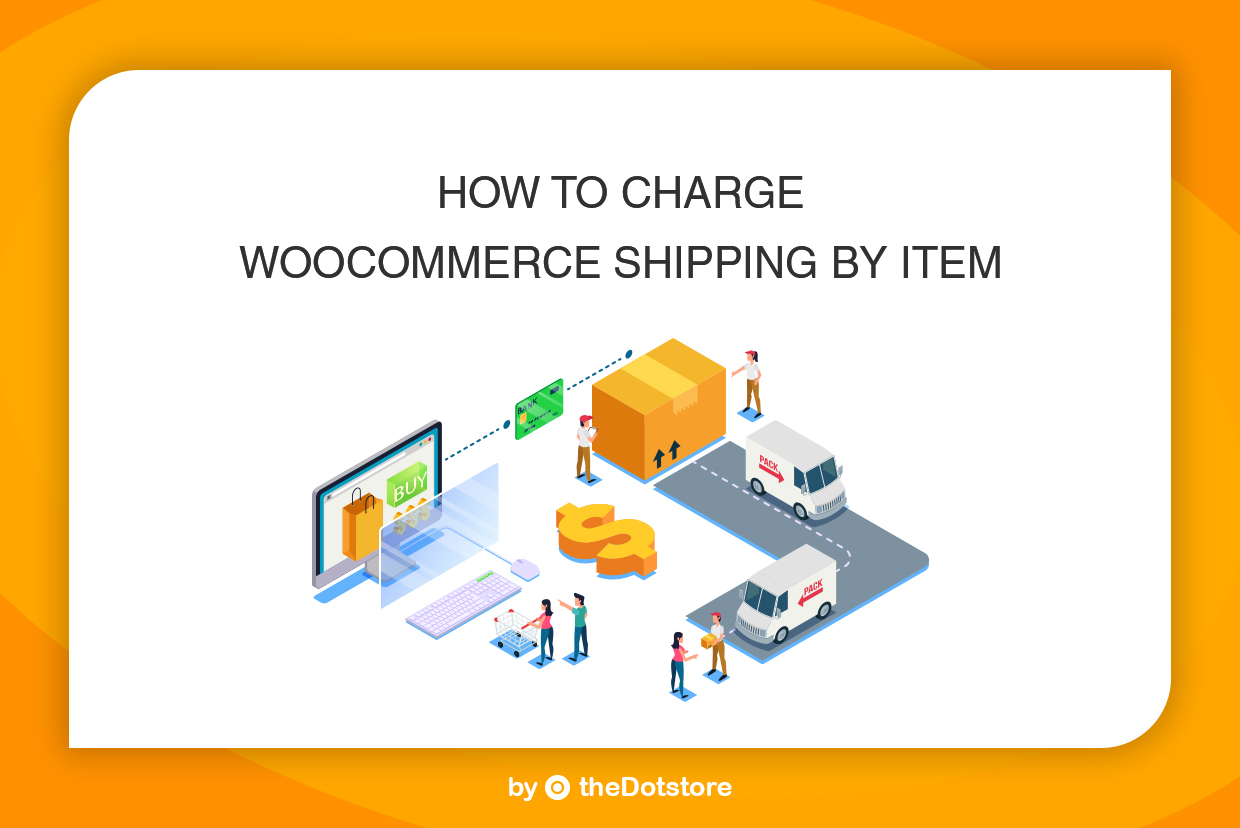Table of Contents
Facing WooCommerce cart abandonment on your online store because your potential customers cant decide for themselves? You’re not alone. Lets explore this phenomenon of decision fatigue in online buyers and learn how to fix this.
All of us have scrolled through page after page of products and felt like shutting down when things on an eCommerce website didnt seem to suit our needs.
According to a recent survey, nearly three‑quarters of online shoppers ditch their carts because the process feels overwhelming. Too many choices and too much information can leave shoppers paralyzed. This problem is called decision fatigue.
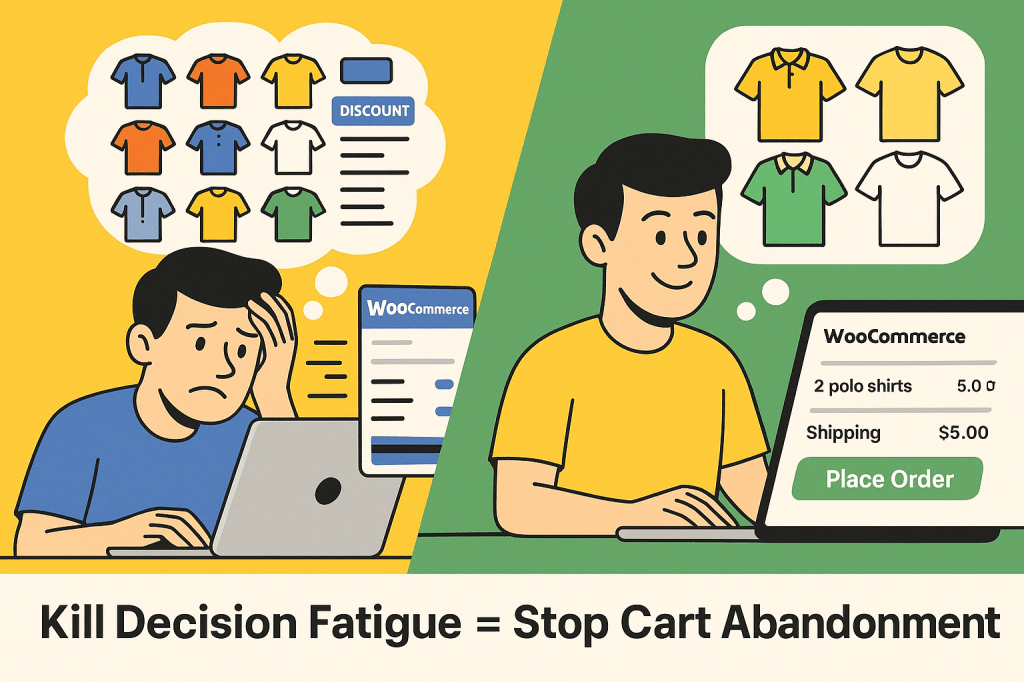
For WooCommerce store owners, this matters. A cluttered catalog or a messy checkout can quietly push customers away, leading to WooCommerce cart abandonment. In this guide, we’ll look at why decision fatigue happens and how it shows up at each stage of the buyer journey.
We’ll also share practical tips and some handy Dotstore plugins that can help you reduce WooCommerce cart abandonment and turn more window shoppers into happy buyers.
What Is Decision Fatigue and How It Impacts WooCommerce Cart Abandonment
Every time you choose between products, payment methods, or even newsletter checkboxes, you’re using up a little bit of mental energy. Psychologists call this “decision fatigue.” After a long stretch of choices, your brain, especially the part responsible for planning and self‑control starts to tire. That’s when people slip into impulse buys, default settings, or simply give up.
The famous “paradox of choice” explains why. Psychologist Barry Schwartz has shown that more choice often makes people less likely to decide at all. It’s why a simple tasting table with six jam flavors sold ten times more jars than a sprawling display with twenty‑four.
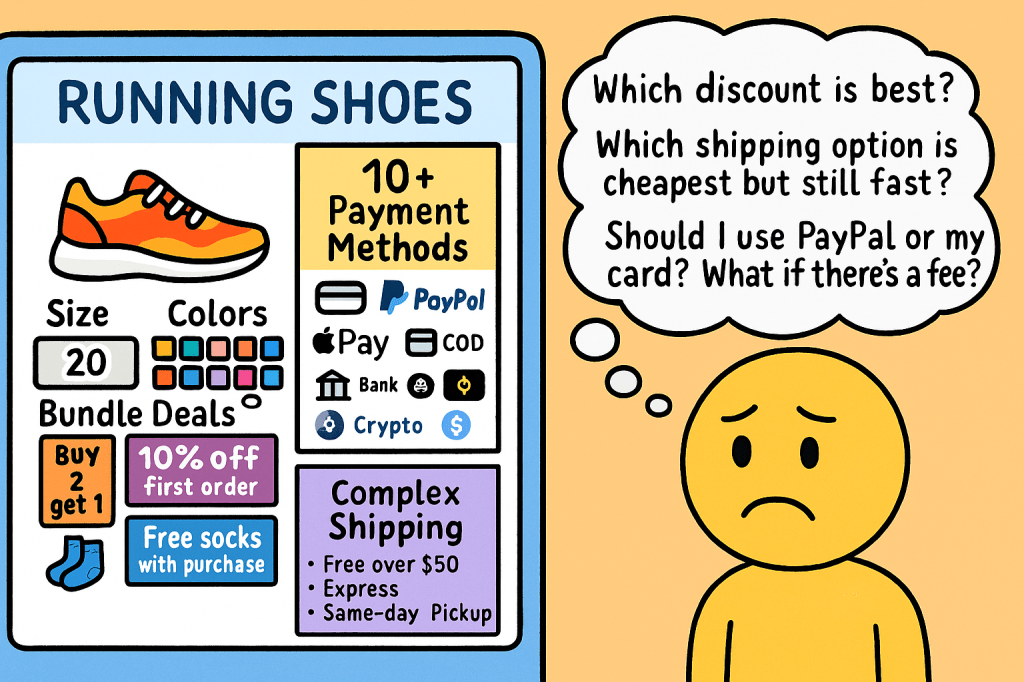
Giving customers more options doesn’t always make them happier; often, it does the opposite. In practical terms, this means that a product category page with dozens of near‑identical items, or a checkout form with too many optional fields, quickly drains a shopper’s attention.
The consequences are real. Recent research found that 74 percent of consumers abandoned their carts because they felt inundated by content and options.
In other words, decision fatigue is directly tied to revenue.
Understanding how and why decision fatigue happens is the first step to reducing it. In the next sections, we’ll map out the typical WooCommerce buyer journey and see where shoppers are most vulnerable to overload.
Mapping the WooCommerce Buyer Journey
Imagine your store from the shopper’s point of view. Before a purchase ever happens, there are a few familiar steps customers tend to follow. Recognizing these stages helps you spot where decision fatigue can creep in.
Phase 1: Awareness
At this first step, people are just realizing they have a need. Maybe they searched Google for “eco‑friendly water bottle” or saw your product shared on social media. They’re curious, but not committed.
For these first‑time visitors or bargain hunters, clear messaging and an easy‑to‑navigate homepage are crucial. Without them, they may never move further into the funnel.
Phase 2: Consideration
Once shoppers land on your site, they start comparing options. Which size? Which color? Is there a warranty? This is where comparison shoppers, gift buyers, and mobile users spend the most time.
Too many product variants or ambiguous information can overwhelm them and slow the decision process. This stage is also where dynamic recommendations and personalization help shoppers quickly zero in on what they really want.
Phase 3: Acquisition (Conversion)
When a shopper adds a product to the cart, they’re getting serious. But the transition from cart to purchase is a fragile moment. Long forms, confusing shipping rules, or a barrage of payment methods often derail the process. It’s no surprise that more than 70 percent of carts are dropped due to unnecessarily complex checkout flows.
Different personas i.e. impulse buyers, bulk purchasers, local versus international customers have varying expectations here. Tailoring payment and WooCommerce shipping options to their context can make all the difference.
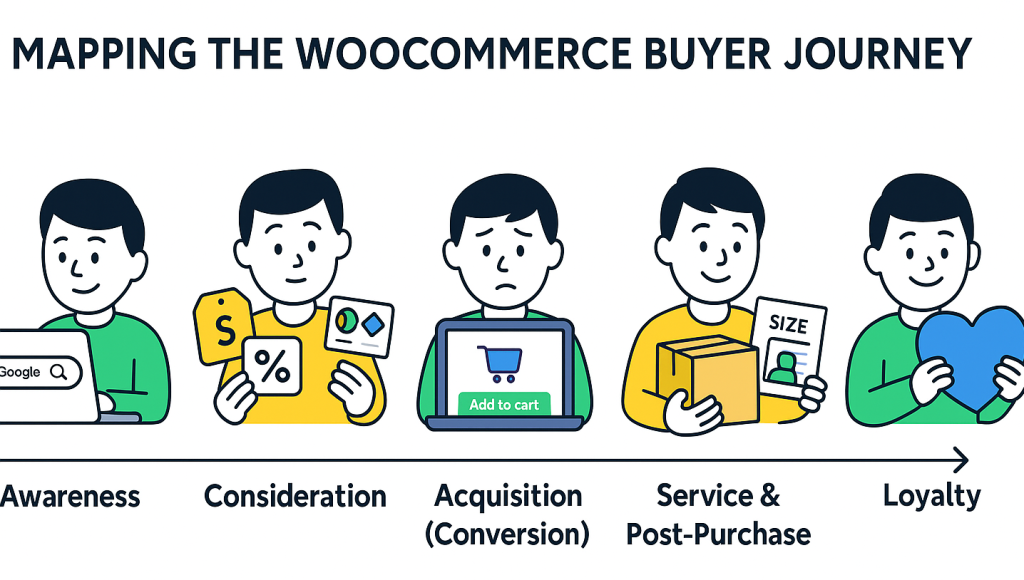
Phase 4: Service & Post‑Purchase
The journey doesn’t end with the transaction. Your new customer might download a digital file, ask about sizing, or need to return or exchange an item. Repeat customers, VIP members, and high‑value shoppers pay close attention to how smoothly you handle these interactions.
Missing size guides or poorly explained policies can turn a one‑time buyer into a lost opportunity.
Phase 5: Loyalty
Finally, there’s the loyalty phase. A small group of loyal customers often brings in a disproportionate amount of revenue—around 44 % and merchants who invest in this stage see substantial growth in repeat business.
The challenge? Keeping engagement high without overwhelming these valuable customers with endless promotions or complicated rewards programs.
Each of these stages offers opportunities to reduce decision fatigue.
Where Decision Fatigue Creeps In
Decision fatigue isn’t limited to the checkout page. It’s woven through the entire shopping experience.
- Too many choices. Studies show that beyond seven to nine options, people struggle to decide. Category pages that feature dozens of similar items without clear grouping can leave visitors stuck.
- Clunky forms. Lengthy checkouts with unnecessary fields drain patience. Asking for information you already have is a good way to make users abandon their cart.
- Irrelevant options. Offering every shipping or payment method often backfires. WooCommerce’s default rules only hide paid shipping when free shipping is available, leaving shoppers to sift through methods they don’t need. This extra evaluation contributes to cart abandonment.
- Missing details. When size charts or product specs are absent or hard to find, shoppers hesitate. Lack of detailed product specifications is a major cause of returns.
- Post‑purchase noise. Even loyal customers can get overwhelmed by a stream of offers and complicated loyalty programs. Since loyal buyers contribute a huge share of revenue, keeping communication simple matters.
By recognizing these pain points, you can start to clear the path.
How to Overcome Decision Fatigue
Making the shopping journey easy doesn’t require a complete overhaul. Here is what you can do.
- Curate your catalogue. Instead of dumping every product on one page, organise items into small collections like “Top Picks” or “Under $50.” People find it easier to choose from shorter lists.
- Reveal details gradually. Keep pages clean and let shoppers click to see more specs or variations. This cuts down on initial clutter.
- Personalise what you show. Use customer data to suggest relevant products and offers. Targeted recommendations and tailored pricing can dramatically improve sales.
- Focus your pages. Each page should have one main goal. Too many buttons or banners split attention, while a single clear call to action has been shown to boost conversions.
- Shorten the checkout. Ask only for what you need, and let customers save their details. Smooth payment options like Shop Pay encourage repeat purchases.
- Provide necessary info up front. Size charts, manuals, and clear return policies reduce confusion and returns.
- Respect post‑purchase attention. Keep follow‑up emails helpful and concise. Loyal customers are your most valuable group, so don’t wear them out with too many promotions.
These simple adjustments can make a big difference in how your shoppers feel and whether they finish their purchase.
Telling shoppers less isn’t about cutting corners it’s about guiding them to the right decision. Dotstore offers a range of plugins that make that guidance much easier.
| Dotstore Plugin | Key Function | Benefit to Decision Fatigue |
| Dynamic Pricing & Discount Rules | Adjust prices by cart total, user role, location | Shows clear, relevant deals instead of many coupons |
| Conditional Payments | Displays payment methods based on cart contents & location | Removes irrelevant payment options, streamlining checkout |
| Hide Shipping Method | Hides shipping options by product type, order value, or user role | Prevents confusion from unnecessary shipping choices |
| Product Attachments | Adds PDFs/manuals/spec sheets to product pages | Reduces uncertainty by providing all necessary info |
| Advanced Product Size Charts | Creates custom size guides for products | Helps customers pick the right size and reduces returns |
| Extra Fees | Offers add‑ons like gift wrapping or express delivery | Makes optional services clear and reduces surprise fees |
| Min/Max Quantity | Sets min/max quantities and step increments | Simplifies quantity selection, prevents ordering mistakes |
| Flat Rate Shipping | Provides predictable per item/order/weight rates | Removes guesswork from shipping costs and speeds checkout |
| Fraud Prevention | Flags or blocks risky orders automatically | Builds shopper trust by reducing fear of fraud |
Aligning specific tools with each stage of the journey ensures your store feels intuitive and tailored, which helps shoppers move from browsing to buying and then back again for more.
Dotstore Power Pack –
19+ Plugins Bundle
Supercharge WooCommerce with our All Access Bundle! Maximize profits, prevent fraud, and empower customers.
14-day, no-questions-asked money-back guarantee.

Awareness & Consideration > Use Product Attachment and Size Charts to make sure shoppers get all the information they need without having to search for it. Help shoppers discover preferences faster with the Product finder plugin.
Curate collections and apply Dynamic Pricing rules to highlight special deals for specific audiences, like first‑time visitors or VIP members.
Acquisition & Checkout > Once shoppers start filling carts, focus on smoothing the path to payment. Hide or show payment and shipping options based on location, product type, or cart value using Conditional Payments and Hide Shipping Method plugin.
Offer add‑ons like gift wrapping or express shipping through Extra Fees, but keep them optional so people don’t feel pressured. Simplify quantity selection with Min/Max Quantity controls and ensure shipping costs are predictable with Flat Rate Shipping plugin. Each of these touches reduces the number of decisions customers must make in quick succession, lowering the chance of abandonment
Service & Loyalty > After a purchase, your goal is to support and retain. Provide download links, manuals, or warranties using the Product Attachment plugin, which cuts down on follow‑up questions and returns. Use Dynamic Pricing to reward loyal shoppers or wholesale buyers with customised discounts.
Finally, keep your store safe and trustworthy by running orders through Advanced Fraud Prevention. A secure and helpful post‑purchase experience encourages customers to come back, boosting that all-important loyal segment.
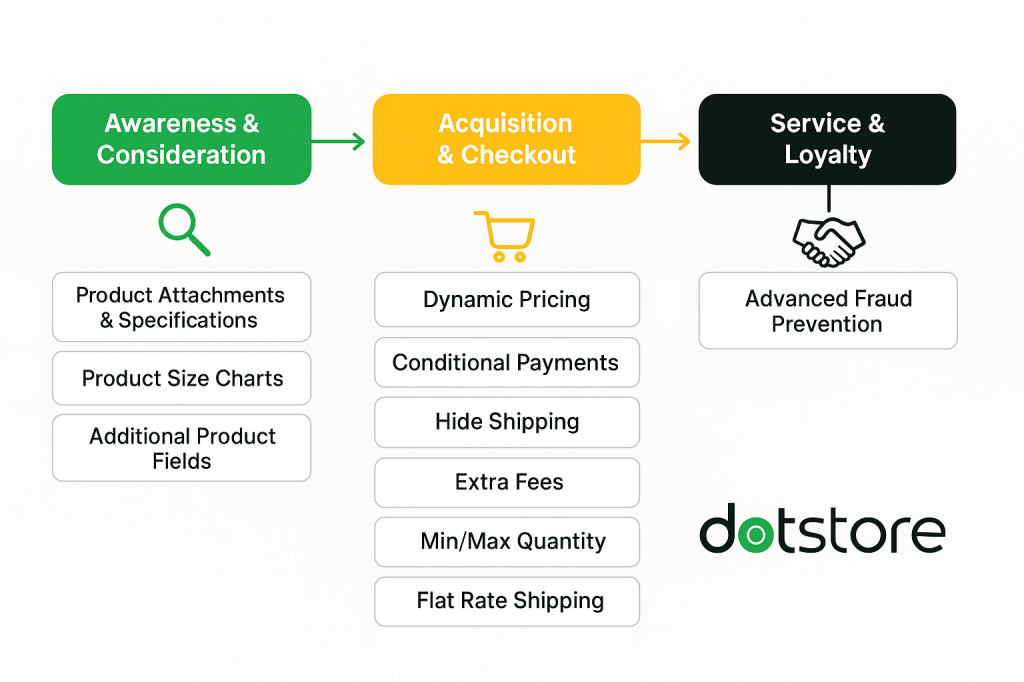
How to Measure Success and Optimize Continuously
After simplifying your store and implementing the right plugins, you’ll want to see results and then keep refining. Start with a few key metrics:
- Conversion rate: Look at how many visitors complete purchases. Improvements here signal that fewer people are dropping off during the decision process.
- Time to purchase: Track how long it takes someone to move from landing on your site to checking out. A shorter span suggests that your changes are reducing hesitation.
- Average order value: When shoppers find it easier to choose add‑ons or higher‑quality products, your average order value can climb.
- Return rate: As size charts and product attachments help customers make informed choices, you should see fewer returns and exchanges.
Most analytics platforms, including WooCommerce’s built‑in reporting, can show these numbers. To dig deeper, consider heatmaps or session recordings to watch where people pause or drop off.
Tools like Google Optimize or Convert can help you run A/B tests—for example, testing a single call to action versus multiple buttons, or trying curated product collections versus a full catalogue.
Don’t treat your plugin settings as “set and forget.” Dynamic pricing and conditional rules may need tweaking as your audience changes or as you add new products. If you notice that a particular payment method isn’t used, you might hide it by default; if a size guide isn’t clear, refine it.
Regularly reviewing your data and making small adjustments keeps decision fatigue at bay and ensures your store evolves with your customers’ needs.
In short, optimization is an ongoing conversation with your audience. Listen to what the numbers tell you, make thoughtful changes, and watch as your store becomes easier for people to love.
Conclusion: Stop WooCommerce Cart Abandonment Today
Reducing decision fatigue is a necessity if you want to overcome WooCommerce cart abandonment. When you trim down choices, personalize offers, and streamline checkout, you replace confusion with clarity.
Dotstore’s plugins give you the tools to make these changes quickly, from smart pricing to simplified payments and shipping. Together, these tweaks can turn casual browsers into loyal buyers.
Take a fresh look at your store today. Identify any points where shoppers might feel overwhelmed, and apply the strategies discussed. A few thoughtful adjustments now will not only reduce decision fatigue in WooCommerce but also build a smoother, more profitable path for every visitor.
Dotstore Power Pack –
19+ Plugins Bundle
Supercharge WooCommerce with our All Access Bundle! Maximize profits, prevent fraud, and empower customers.
14-day, no-questions-asked money-back guarantee.

FAQs about WooCommerce Decision fatigue
What does “decision fatigue in WooCommerce” mean?
It refers to the mental exhaustion shoppers feel on WooCommerce sites when faced with too many options or too much information. As choices pile up, customers are more likely to abandon their carts.
How does decision fatigue in WooCommerce affect my customers?
Choice overload can cause shoppers to leave without buying. More than 70 percent of carts are abandoned on complicated checkouts and reducing decision fatigue in WooCommerce helps combat this trend.
Will reducing decision fatigue in WooCommerce by offering fewer choices hurt my revenue?
Which plugins help reduce decision fatigue in WooCommerce?
Tools like Dotstore’s Dynamic Pricing & Discount Rules simplify promotions. Conditional Payments and Hide Shipping remove irrelevant options at checkout. Product Attachments and Size Charts provide clear information, while Extra Fees and Min/Max Quantity streamline optional services and order quantities


